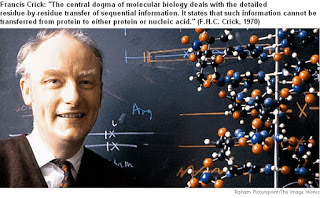March 22, 2015
On the handedness of DNA
March 5, 2015
Don't misuse the word "homology"
January 28, 2015
Vision and Change
January 28, 2015
Evidence-based teaching
January 15, 2015
The Nature of Science (NOS)
January 11, 2015
Why can't we teach properly?
January 8, 2015
Evolutionary biochemistry and the importance of random genetic drift
January 3, 2015
Thinking critically about the Central Dogma of Molecular Biology
December 9, 2014
On the meaning of pH optima for enzyme activity
December 9, 2014
On the specificity of enzymes
December 4, 2014
How to revolutionize education
October 20, 2014
How not to teach biochemistry
October 3, 2014
Metabolism first and the origin of life
September 11, 2014
The mystery of Maud Menten
August 8, 2014
Historical contingency and the evolution of the glucocorticoid receptor
July 28, 2014
Finding the "perfect" enzyme
Jun 2, 2014
"Flipping the classroom": what does that mean?
April 25, 2014
ASBMB Core Concepts in Biochemistry and Molecular Biology: Molecular Structure and Function
April 24, 2014
ASBMB Core Concepts in Biochemistry and Molecular Biology: Biological Information
March 21, 2014
ASBMB Core Concepts in Biochemistry and Molecular Biology: Homeostasis
March 5, 2014
The crystal structure of E. coli RNA polymearse σ70 holoenzyme
January 10, 2014
How not to teach biochemistry at memorize.com
December 9, 2013
Monday's Molecule #226
December 6, 2013
Die, selfish gene, die!
December 6, 2013
Do you understand this Nature paper on transcription factor binding in different mouse strains?
December 2, 2013
Monday's Molecule #225
November 12, 2013
David Evans Says, "Teach What the Vast Majority of Scientists Affirm as Settled Science"
November 5, 2013
Stop Using the Term "Noncoding DNA:" It Doesn't Mean What You Think It Means
October 30, 2013
Time to Re-Write the Textbooks! Nature Publishes a New Version of the Citric Acid Cycle
October 29, 2013
The Khan Academy and AAMC Teach Evolution in Preparation for the MCAT
October 29, 2013
The Khan Academy and AAMC Teach the Central Dogma of Molecular Biology in Preparation for the MCAT
October 29, 2013
The Khan Academy and the Association of American Medical Colleges (AAMC) Team Up to Teach Evolution and Biochemistry for the New MCAT
October 24, 2013
ASBMB Core Concepts in Biochemistry and Molecular Biology: Matter and Energy Transformation
October 15, 2013
ASBMB Core Concepts in Biochemistry and Molecular Biology: Evolution
October 14, 2013
Fundamental Concepts in Biochemistry and Molecular Biology
October 11, 2013
ASBMB Promotes Concept Driven Teaching Strategies in Biochemistry and Molecular Biology
Another curious aspect of the theory of evolution is that everybody thinks he understands it. I mean philosophers, social scientists, and so on. While in fact very few people understand it, actually, as it stands, even as it stood when Darwin expressed it, and even less as we now may be able to understand it in biology. Jacques Monod (1974)October 8, 2013
On the Importance of Defining Evolution
October 6, 2013
Teaching Biochemistry from an Intelligent Design Creationist Perspective
October 1, 2013
The Many Definitions of Evolution
September 30. 2013
The Problems With The Selfish Gene
September 18, 2013
Breaking News!!! Wikipedia Is Wrong! (about the Central Dogma)
September 13, 2013
Sean Carroll: 'What Is Science?"
September 13, 2013
Better Biochemistry: Teaching ATP Hydrolysis for the MCAT
September 12, 2013
Better Biochemistry: Teaching to the MCAT?
June 27, 2013
The Best Enzyme
 April 16, 2013
April 16, 2013Where Do Organisms Get Their Energy?
April 10, 2013
Spontaneous Degradation of DNA
March 18, 2013
Estimating the Human Mutation Rate: Biochemical Method

























